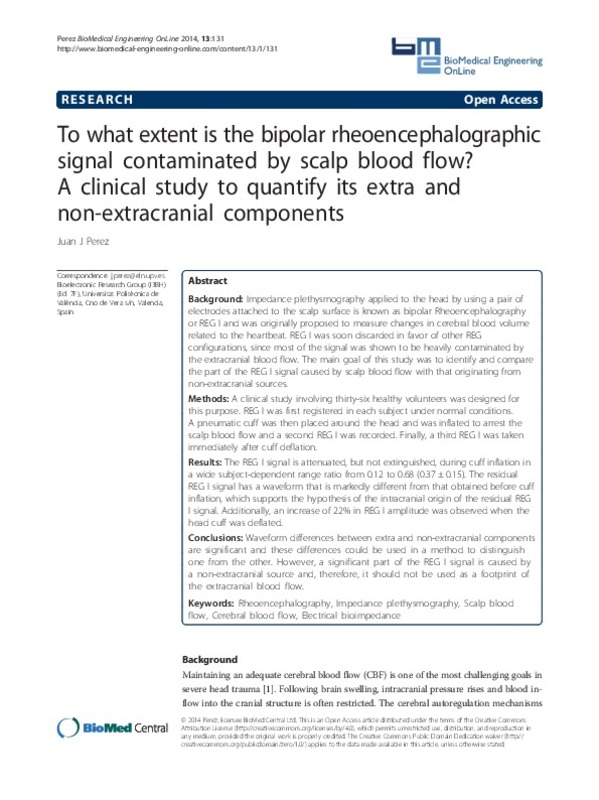Namon, R., & Markovich, S. E. (1967). Monopolar rheoencephalography. Electroencephalography and Clinical Neurophysiology, 22(3), 272-274. doi:10.1016/0013-4694(67)90233-7
McHenry, L. C. (1965). Rheoencephalography: A clinical appraisal. Neurology, 15(6), 507-507. doi:10.1212/wnl.15.6.507
Perez-Borja, C., & Meyer, J. S. (1964). A critical evaluation of rheoencephalography in control subjects and in proven cases of cerebrovascular disease. Journal of Neurology, Neurosurgery & Psychiatry, 27(1), 66-72. doi:10.1136/jnnp.27.1.66
[+]
Namon, R., & Markovich, S. E. (1967). Monopolar rheoencephalography. Electroencephalography and Clinical Neurophysiology, 22(3), 272-274. doi:10.1016/0013-4694(67)90233-7
McHenry, L. C. (1965). Rheoencephalography: A clinical appraisal. Neurology, 15(6), 507-507. doi:10.1212/wnl.15.6.507
Perez-Borja, C., & Meyer, J. S. (1964). A critical evaluation of rheoencephalography in control subjects and in proven cases of cerebrovascular disease. Journal of Neurology, Neurosurgery & Psychiatry, 27(1), 66-72. doi:10.1136/jnnp.27.1.66
Laitinen, L. V. (1968). A comparative study on pulsatile intracerebral impedance and rheoencephalography. Electroencephalography and Clinical Neurophysiology, 25(3), 197-202. doi:10.1016/0013-4694(68)90016-3
Weindling, A. M., Murdoch, N., & Rolfe, P. (1982). Effect of electrode size on the contributions of intracranial and extracranial blood flow to the cerebral electrical impedance plethysmogram. Medical & Biological Engineering & Computing, 20(5), 545-549. doi:10.1007/bf02443401
Hatsell, C. P. (1991). A quasi-power theorem for bulk conductors: comments on rheoencephalography. IEEE Transactions on Biomedical Engineering, 38(7), 665-669. doi:10.1109/10.83566
Basano, L., Ottonello, P., Nobili, F., Vitali, P., Pallavicini, F. B., Ricca, B., … Rodriguez, G. (2001). Pulsatile electrical impedance response from cerebrally dead adult patients is not a reliable tool for detecting cerebral perfusion changes. Physiological Measurement, 22(2), 341-349. doi:10.1088/0967-3334/22/2/306
Bodo, M., Pearce, F. J., & Armonda, R. A. (2004). Cerebrovascular reactivity: rat studies in rheoencephalography. Physiological Measurement, 25(6), 1371-1384. doi:10.1088/0967-3334/25/6/003
Traczewski, W., Moskala, M., Kruk, D., Gościński, I., Szwabowska, D., Polak, J., & Wielgosz, K. (2005). The Role of Computerized Rheoencephalography in the Assessment of Normal Pressure Hydrocephalus. Journal of Neurotrauma, 22(7), 836-843. doi:10.1089/neu.2005.22.836
Bayford, R. H., Gibson, A., Tizzard, A., Tidswell, T., & Holder, D. S. (2001). Solving the forward problem in electrical impedance tomography for the human head using IDEAS (integrated design engineering analysis software), a finite element modelling tool. Physiological Measurement, 22(1), 55-64. doi:10.1088/0967-3334/22/1/308
Chambers, I. R., Daubaris, G., Jarzemskas, E., Fountas, K., Kvascevicius, R., Ragauskas, A., … Sitkauskas, A. (2005). The clinical application of non-invasive intracranial blood volume pulse wave monitoring. Physiological Measurement, 26(6), 1019-1032. doi:10.1088/0967-3334/26/6/011
Davie, S. N., & Grocott, H. P. (2012). Impact of Extracranial Contamination on Regional Cerebral Oxygen Saturation. Anesthesiology, 116(4), 834-840. doi:10.1097/aln.0b013e31824c00d7
Owen-Reece, H., Elwell, C. E., Wyatt, J. S., & Delpy, D. T. (1996). The effect of scalp ischaemia on measurement of cerebral blood volume by near-infrared spectroscopy. Physiological Measurement, 17(4), 279-286. doi:10.1088/0967-3334/17/4/005
Allen, P. J., Polizzi, G., Krakow, K., Fish, D. R., & Lemieux, L. (1998). Identification of EEG Events in the MR Scanner: The Problem of Pulse Artifact and a Method for Its Subtraction. NeuroImage, 8(3), 229-239. doi:10.1006/nimg.1998.0361
Pérez, J. ., Guijarro, E., & Barcia, J. . (2000). Quantification of intracranial contribution to rheoencephalography by a numerical model of the head. Clinical Neurophysiology, 111(7), 1306-1314. doi:10.1016/s1388-2457(00)00304-7
Klemp, P., Peters, K., & Hansted, B. (1989). Subcutaneous Blood Flow in Early Male Pattern Baldness. Journal of Investigative Dermatology, 92(5), 725-726. doi:10.1111/1523-1747.ep12721603
Pérez, J. J., Guijarro, E., & Barcia, J. A. (2004). Influence of the scalp thickness on the intracranial contribution to rheoencephalography. Physics in Medicine and Biology, 49(18), 4383-4394. doi:10.1088/0031-9155/49/18/013
Pérez, J. J., Guijarro, E., & Sancho, J. (2005). Spatiotemporal pattern of the extracranial component of the rheoencephalographic signal. Physiological Measurement, 26(6), 925-938. doi:10.1088/0967-3334/26/6/004
Balédent, O., Fin, L., Khuoy, L., Ambarki, K., Gauvin, A.-C., Gondry-Jouet, C., & Meyer, M.-E. (2006). Brain hydrodynamics study by phase-contrast magnetic resonance imaging and transcranial color doppler. Journal of Magnetic Resonance Imaging, 24(5), 995-1004. doi:10.1002/jmri.20722
Ford, M. D., Alperin, N., Lee, S. H., Holdsworth, D. W., & Steinman, D. A. (2005). Characterization of volumetric flow rate waveforms in the normal internal carotid and vertebral arteries. Physiological Measurement, 26(4), 477-488. doi:10.1088/0967-3334/26/4/013
Wåhlin, A., Ambarki, K., Hauksson, J., Birgander, R., Malm, J., & Eklund, A. (2011). Phase contrast MRI quantification of pulsatile volumes of brain arteries, veins, and cerebrospinal fluids compartments: Repeatability and physiological interactions. Journal of Magnetic Resonance Imaging, 35(5), 1055-1062. doi:10.1002/jmri.23527
Enzmann, D. R., & Pelc, N. J. (1992). Brain motion: measurement with phase-contrast MR imaging. Radiology, 185(3), 653-660. doi:10.1148/radiology.185.3.1438741
[-]









